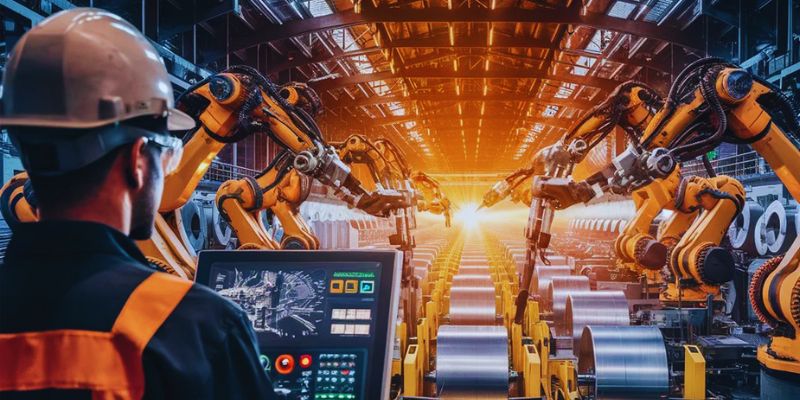Advertisement
Making steel is a difficult and expensive endeavor. From heating metal to molding it, every step needs careful planning. Rising labor, materials, energy, and tool prices drive steel manufacturers toward more creative savings strategies. Artificial intelligence (AI) helps here. Artificial intelligence is altering manufacturing processes by being faster, more cost-effective, and more efficient. Recently, one steel company turned to artificial intelligence to lower costs and boost output.
The outcomes were very remarkable. Artificial intelligence supports every level, from improved energy regulation to better utilization of raw resources. This article will show how steel manufacturers reduce expenses using artificial intelligence without compromising quality. Find out how technology changes the steel sector and what this implies about manufacturing in the future.

Here are the key ways AI helps the steel producer reduce costs and improve plant operations:
Steelmaking calls for expensive commodities, including coal, iron ore, and scrap metal. If too much is consumed, expenses climb quickly. One avoids this using artificial intelligence. AI systems evaluate present needs and prior manufacturing data to determine the quantity of each batch required. It ensures effective input levels and helps decrease waste. AI also verifies the incoming material quality. If some have low quality, the procedure is altered to prevent bad steel. The firm uses less material yet produces better steel. It reduces waste and helps one save money. Smart planning also avoids mistakes that lead to rejected batches. Over time, raw material efficiency results in rather large savings.
Steel plants melt, shape, and roll metal using much energy. Fuel and electricity are rather expensive. AI improves the management of this. Sensors record machine and furnace power use. AI tools search this data for places of energy waste. Sometimes, artificial intelligence significantly decreases the furnace temperature without compromising quality. It might also move operations to off-peak hours when power is less expensive. Machines automatically power down when not in use. Applying these artificial intelligence techniques, one steel plant cut energy consumption by 15%. Reduced energy consumption translates into lower expenses. Another advantage of this approach is that it aids in meeting environmental goals.
Work pauses in a steel mill when equipment fails. It costs a lot of money and causes delays. Correcting damaged components also requires time. Predictive maintenance is one way AI aids. This system logs machines using sensor data. It finds little problems before they become major—AI sends early warnings when a part is about to fail. Then, rather than waiting for a breakdown, repairs can be planned during quiet periods. It ensures the flawless operation of the production line. One steel manufacturer cut machine downtime by thirty percent with artificial intelligence. That is a rather large benefit. Less downtime generally results in higher productivity, fewer emergency repairs, and fewer costs.

Making steel can be difficult. If something goes wrong, a whole batch can be thrown away. It has not been sold and possibly even caused equipment damage. It is bad-quality steel. With clever quality control systems, artificial intelligence enhances this. Throughout manufacture, cameras and sensors track the steel. AI analyzes real-time data. If something is off—like mix or temperature—it adjusts settings immediately. It maintains quality and helps to prevent flaws. Good quality control produces happier consumers and less rejected products. Less trash also lowers expenses. Using artificial intelligence over time produces more consistent goods.
Decisions at a busy steel plant have to be taken fast. Changes in staff, equipment, or orders need quick responses from managers. AI tools analyze data from several sources at once—like machine status, orders, and worker schedules—helping here. These tools then point to the optimal course of action. Artificial intelligence might rapidly rearrange tasks onto alternative lines if a machine malfunctions. It keeps missed deadlines and delays away. Managers do not have to waste time personally going over all the data. Using AI-driven planning, one steel manufacturer cut costs and enhanced delivery times.
Producers of steel demand a seamless supply network. Finished goods must ship fast, and raw supplies must arrive on schedule. AI facilitates this. It logs storage levels, shipment times, and supply paths. AI provides backup strategies if a supplier causes a delay. If the stock is low, it orders early. AI also helps avoid overstocking, which ties down cash and requires space. One steel company cut delays by better-managing suppliers using artificial intelligence. Real-time tracking helps artificial intelligence keep operations running without interruptions.
Using artificial intelligence in steel manufacturing offers one of the main benefits—real-time monitoring. AI systems gather live data from sensors on manufacturing lines, furnaces, and machinery. This data comprises temperature, pressure, energy use, machine speed, and more. Instantaneously analyzing this data, artificial intelligence software notifies employees if something is wrong. For instance, the technology alerts staff immediately if a furnace runs too hot or a machine slows down. Fast solutions made possible by quick alerts stop damage and downtime.
Managers can also view live reports from anywhere—including on cell phones. It enables them to make better real-time decisions. Real-time observation also lessens human mistakes. AI never gets bored or distracted, so nothing is missed. These systems compile data trends over time to guide future enhancements. Higher efficiency, better quality, and lower expenses follow from this.
Steel production is undergoing a major transformation thanks in part to artificial intelligence. It increases product quality, lowers energy use, and helps to cut expenses. From better raw material planning to real-time monitoring, artificial intelligence helps to enable fewer errors and better decisions. It also enhances supply chain flow and reduces machine downtime. Less waste and more profit follow from these developments. One steel business found significant savings from artificial intelligence without compromising quality. The whole sector will get faster, smarter, and more efficient as more steel makers embrace this technology.
Advertisement

Need smarter workflows in Google Sheets? Learn how to use GPT for Sheets and Docs to write, edit, summarize, and automate text with simple AI formulas

Learn about fintech’s AI challenges: explainability gaps, synthetic identity fraud, compliance requirements, and others.

Discover how deep learning and neural networks reshape business with smarter decisions, efficiency, innovation, and more

Want to run Auto-GPT on Ubuntu without Docker? This step-by-step guide shows you how to install Python, clone the repo, add your API key, and get it running in minutes

Explore the features, key benefits, and real-world use cases of ERP AI chatbots transforming modern enterprise workflows.

Lenovo is transforming industries by bringing generative AI to the edge with powerful hardware and real-time solutions.

Discover how a steel producer uses AI to cut costs, improve quality, boost efficiency, and reduce downtime in manufacturing

Looking to edit music like a pro without being a composer? Discover Adobe’s Project Music GenAI Control, a tool that lets you create and tweak music tracks with simple commands and no re-rendering required

Curious about Arc Search? Learn how this AI-powered browser is reshaping mobile browsing with personalized, faster, and smarter experiences on your iPhone

Trying to choose between ChatGPT and Google Bard? See how they compare for writing, research, real-time updates, and daily tasks—with clear pros and cons

Top AI hardware vendors join forces to compete with Nvidia and reshape the AI infrastructure market.

Understand how mixture-of-experts models work and why they're critical to the future of scalable AI systems.